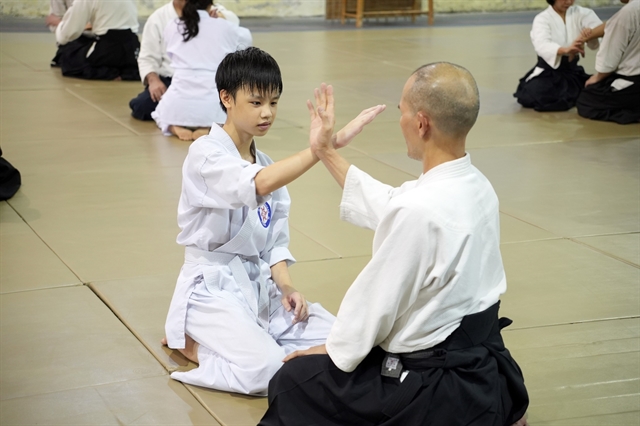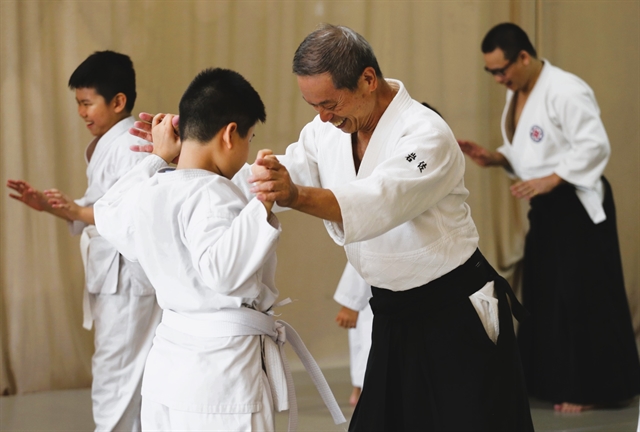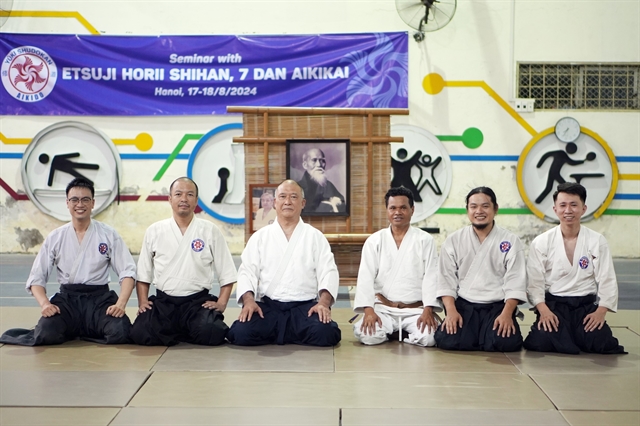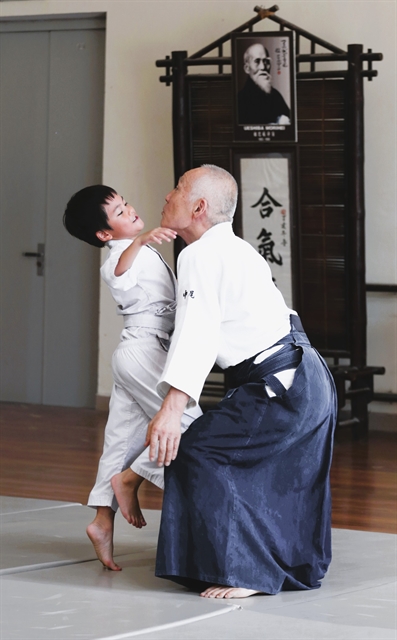Martial art for peace
Culture - Ngày đăng : 16:54, 23/10/2024
By Quỳnh Anh*
HÀ NỘI — Nestled in the bustling heart of the capital, an Aikido club offers a sanctuary for those wishing to cultivate tranquility and joy through this martial art, often referred to as the 'Martial art for peace'.
 |
| Aikido is now practised in around 140 countries. Photo courtesy of Aikido Yuuki Shudokan Club |
In the relentless pace of modern life, many seek out hobbies that allow them to be their authentic selves and escape their daily routines.
Some find solace in the vibrant rhythm of dance, while others cherish the few moments they have to enjoy their favourite beverages. There are those who embrace challenges in sports, setting personal goals to strive for.
Everyone can carve out a unique space to regain emotional equilibrium and recharge after a long day of work or study.
Nestled in the bustling heart of the capital, an aikido club offers a sanctuary for those wishing to cultivate tranquility through this martial art, often referred to as the 'Martial art for peace'.
Aikido is one of the most popular Japanese martial arts in Việt Nam. It was introduced in 1958 but gained widespread recognition after 2000.
Since then thousands have embraced its philosophy and techniques reflecting a growing interest in this harmonious martial art.
 |
| Aikido curricula emphasise throws, teaching beginners how to fall or roll safely. Photo courtesy of Aikido Yuuki Shudokan Club |
Aikido was created by Morihei Ueshiba (1883–1969), who envisioned it as an expression of universal peace and reconciliation.
The name of the martial art is derived from three meaningful components: ai stands for harmony or unifying ki represents energy or spirit and dō signifies way or path.
Aikido aims to utilise the power of an attacker's movements to control his/her actions with minimal effort.
With over 24 years of experience in aikido, trainer Lê Hoàng Hải not only hones his own skills but also inspires many students to practise this humanistic martial art.
“Aikido’s biggest philosophy is not using violence,” Aikido trainer Lê Hoàng Hải told Việt Nam News.
“We apply aikido’s techniques to find the harmony between humans, the universe and nature.
“While practising aikido, we take great care of the safety for the person practising with us,” he said.
Martial arts are often seen as powerful and decisive, but in aikido, practitioners’ fluid movements resemble a dance.
This emphasis on grace and harmony transforms combat into a beautiful art form focused on conflict resolution.
This martial art seems to suit people of all ages due to its flexibility and adaptability.
Each person comes to aikido with a purpose. Some love Japanese culture, others like martial arts.
 |
| Aikido Yuuki Shudokan Club is a vibrant community uniting enthusiasts from various countries. Photo courtesy of Aikido Yuuki Shudokan Club |
Kimura Zakuto has lived in Hà Nội for two years, having initially practiced aikido in Ho Chi Minh City, before relocating.
Although the origins of aikido came from his home country, he never tried it until he moved to Việt Nam.
“I first found it weird that this Japanese martial art is taught in Vietnamese,” he said.
“Sometimes I don’t understand what the trainer says. But it’s ok, feeling is more important so I can still practise it,”
Aquilino Amaral from Timor Leste firmly believes in making friends, not enemies and this is the best place to do it.
The embassy employee said: “This club is more relevant to my aikido than the one I used to practise in my country.
“I feel it’s good for me and comfortable here to practise more and to be more relaxed,”
“This is a modern period that we have to be more friendly with others. Not to find the enemy, but to try to find more friends than enemies,” he added.
Trần Đức Phấn is the oldest student at the club and has been training in aikido since 2006.
“It’s different from any other martial art,” he said.
"In a conflict, the ultimate peak is to achieve victory without resorting to violence. It trains persistence, hard work and a strong will to overcome difficulties in practice.
“In that way, it helps train a will to overcome all pressure in work and life.”
In this class, young students can be seen training with remarkable enthusiasm and a deep commitment to aikido, eager to forge a lasting connection with the art.
“I want to practice longer, reach a higher level and gain more skills to protect myself,” said Nguyễn Vũ Hoàng Lan, one of the youngest female members of the class.
“I found myself behaving better with other people in the club. I think children need this,” said Lê Hồng Thu, who has been practising this kind of martial art since she was 14 years old.
The aikido movement has spread widely across Việt Nam, with Hồ Chí Minh City leading the charge. It has also reached neighboring provinces and cities such as Đà Lạt, Bình Dương, An Giang, Nha Trang, and Hà Nội. Many dojos can be found in regions like Huế and Quảng Trị, contributing to a vibrant national network of practitioners.
Making the right moves to find harmony and plenty of inner peace. — VNS
 |
| The martial art can be suitable for people of all ages. Photo courtesy of Aikido Yuuki Shudokan Club |
* (with additional interview by Lê Hương)
